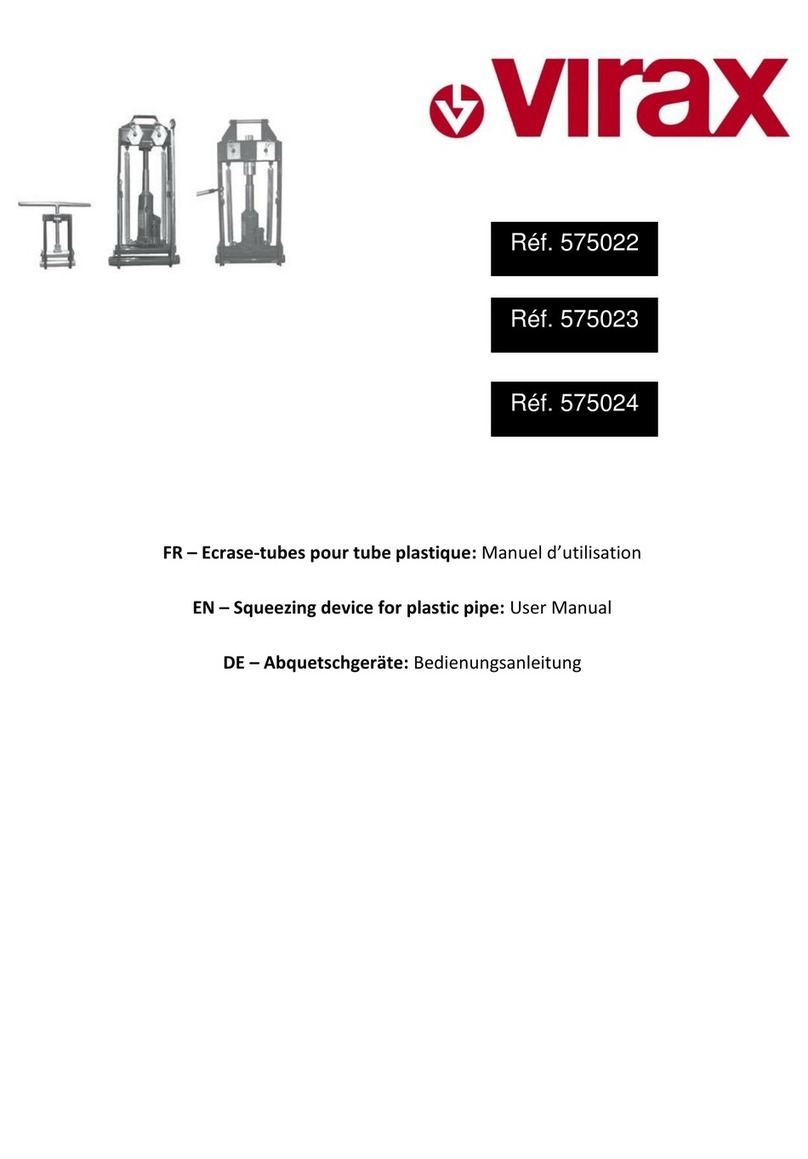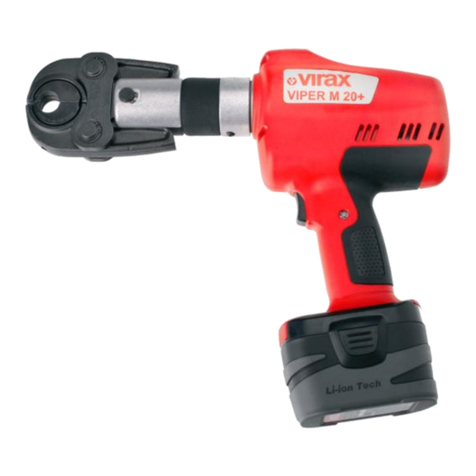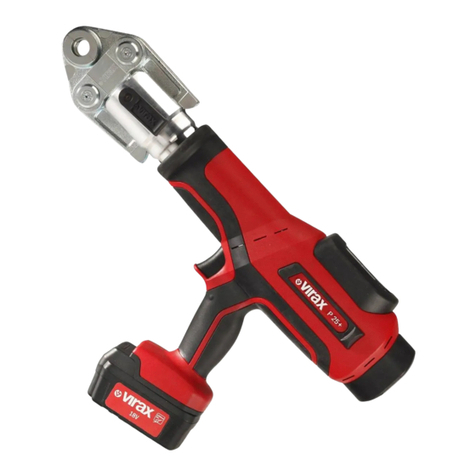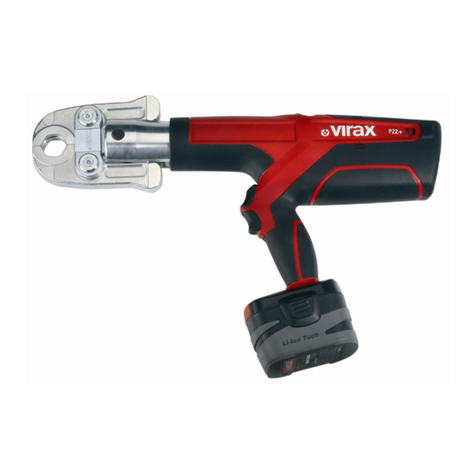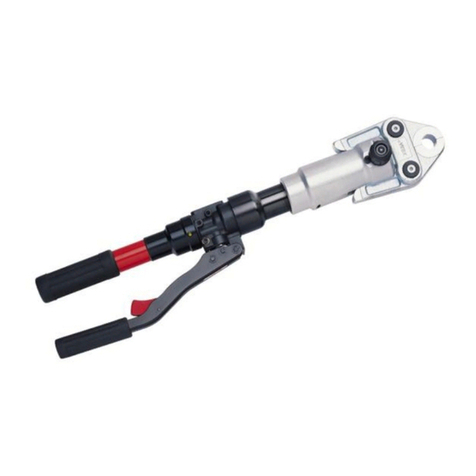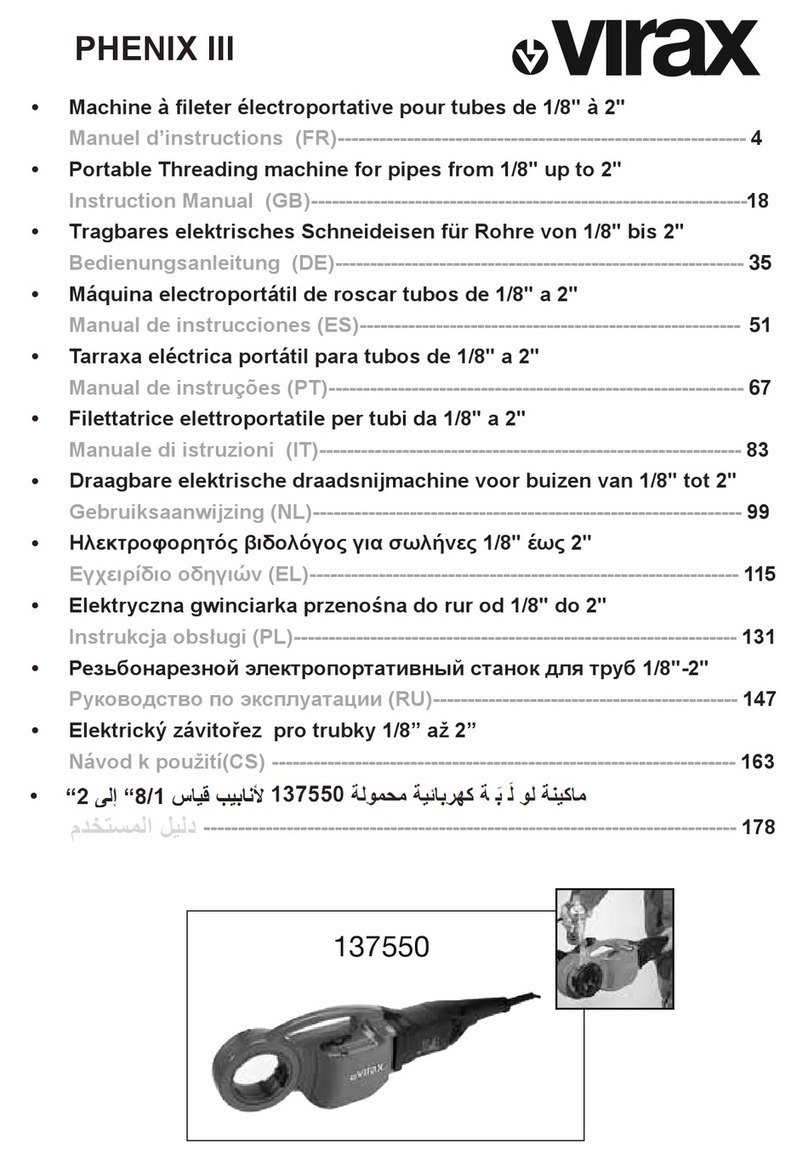
2
Déclaration CE de Conformité
CE Declaration of Conformity - EG-Konformitätserklärung - Dichiarazione di conformità CE - Declaración de Conformidad CE
- Declaração CE de conformidade - CE-conformiteitsverklaring - Δήλωση συμμόρφωσης CE - Deklaracja zgodności CE -
Prohlášení ES o shodě – Декларация ЕС осоответствии - AT Uygunluk Beyanı
VIRAX - 39 quai de marne - 51200 Epernay
France / Frankreich / Francia / França / Frankrijk / Γαλλία / Francja / Francie / Франция / Fransa
NOUS, VIRAX S.A.S., DECLARONS SOUS NOTRE PROPRE RESPONSABILITE QUE LE(S) PRODUIT(S) :
WE, VIRAX S.A.S., DECLARE UNDER OUR OWN CIVIL REPONSIBILITY THAT THE PRODUCT(S):
WIR, DAS UNTERNEHMEN VIRAX S.A.S., ERKLÄREN AUF EIGENE VERANTWORTUNG, DASS DAS (DIE) PRODUKT(E):
LA SOTTOSCRITTA, VIRAX S.A.S., DICHIARA SOTTO LA PROPRIA RESPONSABILITÁ CHE IL(I) PRODOTTO(I):
NOSOTROS, VIRAX S.A.S., DECLARAMOS BAJO NUESTRA PROPIA RESPONSABILIDAD QUE EL(LOS) PRODUCTO(S):
NÓS, A VIRAX S.A.S., DECLARAMOS SOB NOSSA RESPONSABILIDADE QUE O(S) PRODUTO(S):
WIJ, VIRAX S.A.S., VERKLARING OP ONZE EIGEN VERANTWOORDELIJKHEID DAT HET/DE PRODUCT(EN) :
ΕΜΕΙΣ, Η VIRAX S.A.S., ΔΗΛΩΝΟΥΜΕ ΜΕ ΔΙΚΗ ΜΑΣ ΕΥΘΥΝΗ ΟΤΙ ΤΟ/ΤΑ ΠΡΟΪΟΝ/ΠΡΟΪΟΝΤΑ:
MY, VIRAX S.A.S., OŚWIADCZAMY Z PEŁNĄ ODPOWIEDZIALNOŚCIĄ, ŻE PRODUKT(Y):
MY, VIRAX S.A.S., PROHLAŠUJEME NA SVOU VLASTNÍ ODPOVĚDNOST, ŽE VÝROBEK (VÝROBKY):
МЫ, КОМПАНИЯ VIRAX S.A.S., ЗАЯВЛЯЕМ ПОД СВОЮ ОТВЕТСТВЕННОСТЬ, ЧТО ИЗДЕЛИЕ(Я):
BİZ, VIRAX S.A.S. OLARAK, KENDİ SORUMLULUĞUMUZ ALTINDA, ÜRÜN VE ÜRÜNLERİMİZİN AŞAĞIDA BELİRTİLEN :
Ref. 138020/21 – Filière électroportative Mini-Phénix
Portable threading mini-machine / Mini-filettatrice elettroportatile / Mini- máquina electroportátil para roscar / Mini-tarraxa
eléctrica portátil / Mini-draagbare elektrische draadsnijmachine / Mini-elektryczna gwinciarka przenośna / Mini-Tragbares
elektrisches Schneideisen / Mini elektrotechnický průmysl / Мини Резьбонарезной электро портативный станок / Μίνι
Ηλεκτροφορητός βιδολόγος / Mini taşınabilir elektrik sektöründe
•EST / SONT CONFORME(S) AUX DISPOSITIONS DE LA (DES) DIRECTIVE(S) EUROPENNE(S) SUIVANTE(S) :
CONFORM TO THE PROVISIONS IN THE FOLLOWING EUROPEAN DIRECTIVE(S) :
ÜBEREINSTIMMT/ÜBEREINSTIMMEN MIT DEN BESTIMMUNGEN DER FOLGENDEN EUROPÄISCHEN RICHTLINIE(N):
É / SONO CONFORME(I) ALLE DISPOSIZIONI DELLA(E) SEGUENTE(I) DIRETTIVA(E) EUROPEA(E):
ES / SON CONFORME(S) CON LAS DISPOSICIONES DE LA (DE LAS) DIRECTIVA(S) EUROPEA(S) SIGUIENTE(S):
ESTÁ(ÃO) EM CONFORMIDADE COM AS DISPOSIÇÕES DA(S) DIRECTIVA(S) EUROPEIA(S) SEGUINTE(S):
CONFORM IS/ZIJN MET DE BEPALINGEN VAN DE VOLGENDE EUROPESE RICHTLIJN(EN) :
ΣΥΜΜΟΡΦΩΝΕΤΑΙ/ΣΥΜΜΟΡΦΩΝΟΝΤΑΙ ΠΡΟΣ ΤΙΣ ΔΙΑΤΑΞΕΙΣ ΤΗΣ/ΤΩΝ ΑΚΟΛΟΥΘΗΣ/ΑΚΟΛΟΥΘΩΝ
ΕΥΡΩΠΑΪΚΗΣ/ΕΥΡΩΠΑΪΚΩΝ ΟΔΗΓΙΑΣ/ΟΔΗΓΙΩΝ:
JEST/SĄ ZGODNY/-E Z PRZEPISAMI NASTĘPUJĄCYCH/-EJ DYREKTYW(Y) EUROPEJSKICH/-EJ:
ODPOVÍDÁ / ODPOVÍDAJÍ USTANOVENÍM NÁSLEDUJÍCÍ EVROPSKÉ SMĚRNICE (SMĚRNIC):
ОТВЕЧАЕТ(ЮТ) ПОЛОЖЕНИЮ (ЯМ) СЛЕДУЮЩЕЙ(ИХ) ЕВРОПЕЙСКОЙ(ИХ) ДИРЕКТИВЫ(ИВ) :
AVRUPA DİREKTİFLERİ TALİMATLARINA UYGUNLUĞUNU :
- MSD 2006/42/CE : Directive Machines / Machine Directive / Maschinenrichtlinie / Direttiva Macchine / Directiva Máquinas /
Directiva Máquinas / Machinerichtlijn /Οδηγία σχετικά με τα μηχανήματα / Dyrektywa maszynowa / směrnice o strojních
zařízeních / Директива по машиностроению / Makine Direktifi
- LVD 2006/95/CE : Directive Basse Tension / Low Voltage Directive / Niederspannungsrichtlinie / Direttiva bassa tensione /
Directiva Baja Tensión / Directiva Baixa Tensão / Laagspanningsrichtlijn / Οδηγία χαμηλής τάσης / Dyrektywa
niskonapięciowa / směrnice o nízkém napětí / Директива по низкому напряжению / Alçak Gerilim Direktifi
- EMC 2004/108/CE : Directive Compatibilité Electromagnétique / Electromagnetic Compatibility Directive / Richtlinie über die
Elektromagnetische Verträglichkeit / Direttiva compatibilità elettromagnetica / Directiva Compatibilidad Electromagnética /
Directiva Compatibilidade Electromagnética / EMC-richtlijn (elektromagnetische compatibiliteit) / Οδηγία περί
ηλεκτρομαγνητικής συμβατότητας / Dyrektywa „Kompatybilność elektromagnetyczna / směrnice o elektromagnetické
kompatibilitě / Директива по электромагнитной совместимости / Elektromanyetik Uyumluluk Direktifi
La personne autorisée à constituer le dossier technique est / The person who is authorized to create the technical
brichure is / Der Berichtigte zur bildung der technische Broschüre ist / La persona autorizzata a costituire il fascicolo tecnico
risponde al nome di / Technisch bestand verkrjigbaar / La persona autirizada a constituir el fasciculo tecnico es
J.I. Pikaza
J. Raudin, le directeur général / The managing director / L'amministratore delegato / El director gerente / O director-geral /
De gedelegeerd bestuurder / Ο διευθύνων σύμβουλος / Dyrektor zarządzający / Der Geschäftsführer / Generální ředitel /
Управляющий директор / Genel Müdürü
J. Raudin
Le 9 octobre 2013





